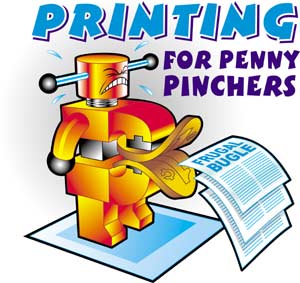 |
|
||||||||||||
|
Columns by Linda Formichelli:
List all of Linda's columns
Visit our other Getting Work columnist
|
It's a paradox: If you're in need of printed materials, chances are you're a fledgling IP. If you're a fledgling IP, your marketing budget probably consists of money you earned selling Pokemon cards on eBay. What's an IP to do? The answer's simple: read this column. I have lots of experience in this area because I've written for numerous printing trade magazines, and I just bought new letterhead and cards. Trust me, OK? OK. When it comes to printing, you've got three options: cheap, cheaper, and cheapest. Cheap You may think that a professional printer is out of your league -- but that's because you haven't been privy to the cost-cutting strategies I'm about to outline here. "The first step is finding a reliable printer. You can learn a lot by talking with an experienced, patient printer," says Jennifer Proia, an IP graphic designer. "When I send out for printing bids -- this is called a 'Request for Quote' or RFQ -- I request prices from three or four different printers. Give them all the same parameters and see how the quotes come in." If you can manage to escape your office long enough to visit a few print shops (hey, you're an IP!), go and check out the staff and customers. Are the customers happy, or are the majority of them crying and covered with boot prints? Do the staff members know what they're talking about, or do they wince when you ask the difference between engraving and embossing? Ask for samples. "Look less at the design of the piece and more at the production quality," says Proia. "Note how well items come together on the page (known as the 'registration'), how crisp and clear the text and pictures are, how saturated the ink is. Is everything straight and even?" Ask them about turnaround, price, and how you should submit the file or art. Maybe you're so cheap that when you open your wallet, George Washington blinks from the light. If so, you'll need to do more than select the best work at the lowest bid. Slice your spending even further by following these penny-pinching suggestions from Proia and Darlene Moore, president of the Inktracks Printing Group in Laguna Hills, Calif.
Cheaper If there's anything you can't do on the Web, I don't want to hear about it. (No, really. I said I don't want to hear it! I'm not listening -- la la la la la la!) With the help of the Web, you can create, order, and receive your printing in about 48 hours. But if convenience isn't enough of an incentive, then your inherent IP miserliness should be. Web-based printers can save customers between 25 and 50 percent off prices at traditional print shops. Companies like kinkos.com and iPrint.com guide you step-by-step through designing business stationery, and they offer a multitude of other office products, like rubber stamps, mailing labels, and even personalized Post-it Notes. Like all good things, this one comes with a warning tag attached: "It's important to develop a relationship with a good-quality local printer you know and trust. It doesn't work for me to outsource to someone I know only digitally," says Proia. "Also, online printers generally focus more on quantity over quality, which is fine for large marketing promotions but isn't optimal for a run of 500 two-color business cards." Cheapest For the skinflints who are still with me, the very cheapest way to create printed materials is to do it yourself. Nowadays, you don't even have to haul your ass to Kinko's to turn out business cards or letterhead. If you use the Microsoft Office package, for instance, you already have everything you need. Microsoft Publisher has several pre-formatted templates to choose from, designed for all manner of professionals. Microsoft Word has similar capabilities. All you have to do is fill in the blanks. Any office supply store, such as Office Max or Staples, sells off-the-shelf packs of business cards and stationery. You can also get stationery sets from catalogs like Paper Direct. The good news is that these options are cheap and convenient. The downside is that your prospects can smell Paper Direct's Acropolis design a mile away. There is a way to create a more professional image, but it will mean (I hope you're sitting down for this) getting out of your chair. Print the business cards and letterhead with a laser printer onto quality stock, and then trot on over your local print shop or office supply store. Using the store's paper cutter, cut out the business cards. Be sure to bring a few practice sheets, as every paper cutter seems to have been designed by blind monkeys that -- while skilled in the fundamentals of metalworking -- somehow cannot match up two lines. The same software programs that let you create letterhead and business cards will also turn out professional-looking envelopes. But if the idea of watching envelope flaps get mangled in your printer doesn't thrill you, try a rubber stamp or printer-friendly address labels from office supply stores or online. The options in this section are temporary solutions to tide you over until you have two bills to rub together. Then you must go out and get yourself some professional materials -- they'll pay for themselves by building your image and attracting bigger clients. |
|
|
We'd love to hear your feedback about this column, or put you in touch with Linda Formichelli if you like. You may also like to see her biography. Illustration by Steve Smallwood. |
The 1099 name and logo are trademarks of 1099 Magazine.

